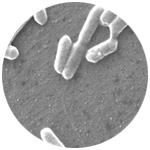c. Escherichia coli (Plate 3)
|

|
E coli is a diverse group of bacteria and only a few strains cause disease by making a toxin called Shiga toxin. The toxin-producing bacteria are known as “Shiga toxin-producing” E coli or STEC. The most commonly identified STEC in North America is E coli O157:H7. Other serogroups can also produce infections.
Fewer than half of all pediatric urinary tract infections are susceptible to commonly prescribed antibiotics (Gaspari et al. 2006). The prevalence of E coli resistant to amoxicillin with ESBLs responsible for the community-acquired urinary tract infections (CA-UTIs) in Phnom-Penh, Cambodia, was reported to be in excess of 82.3% (Ruppé et al. 2009). CA-UTIs were also resistant to cotrimoxazole (75.3%), ciprofloxacin (67.7%), gentamicin (42.5%), and third-generation cephalosporins (37.7%). MDR strains resistant to fluoroquinolones and aminoglycosides have emerged recently (DuPont et al. 2009).
In the United States, resistance is also on the rise. A large study of children treated for UTIs found that long-term use of antibiotics appeared to reduce the risk of relapse, but the benefit was small and must be weighed against the development of resistance (Williams and Craig 2011). More than 48% of self-serve beverage and soft drink dispensing fountains have been found to be contaminated by coliform bacteria, including E coli (White et al. 2010). NDM-1, a gene responsible for AMDR, has been isolated from the E coli residing in drinking fountains and soil water in India. This gene can spread to other bacteria and confer resistance to the last-resort antibiotics called carbapenems. NADM-1 has been already found in France and in some UK hospitals, as well as among patients undergoing treatment in India and those suffering from “traveler’s diarrhea” (Diene et al. 2011; Walsh et al. 2011).
In May 2011, STEC O104:H4 was reported among several travelers returning to the United States from Germany. The Germany-based Robert Koch Institute reported several hundred cases of hemolytic uremic syndrome and deaths due to the STEC O104:H4, presumed to originate from the ingestion of raw vegetables (Robert Koch Institute 2011; Centers for Disease Control and Prevention 2011).
|



